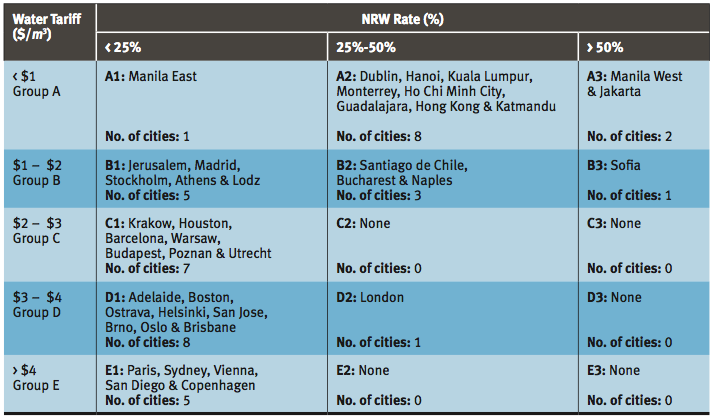Non-Revenue-Water in Europe
Our water pipes are full of holes. Every day 45 billion (!) litres of water leak through cracks in pipes of public water systems in developed countries. That would be enough to supply 200 million people worldwide with fresh water. Unfortunately, little is done about it because our water is too cheap.

Imagine a grain grower. Every day he sends four truckloads of wheat to the market and every day one of his trucks goes missing and returns without cargo. But instead of investigating the cause he just sends another one. Hard to believe? Well, our drinking water works quite similarly. 25 percent of it gets lost before it reaches the consumer. This was estimated by a study made for the World Bank in 2006. The reason for it lies in badly executed monitoring or water theft. But mostly it is because of rotten plumbing, leaks in pipes through which the water trickles into the soil. Leaks, which nobody repairs because it is cheaper to pump new water into the system until the pressure is even again.
This is far from being a secret. NRW is the official short form for Non-Revenue-Water. Water, which was pumped into the public system but does not reach the consumer. The NRW rates of almost every country of the world are too high. Experts and politicians agree to this, but nobody seems to know exactly how high the rates really are. IBNET, the energy and water department of the World Bank, has made an interactive map, which gives an overview of water values around the world. Beneath values like national water consumption and costs, the percentage of NRW is also displayed. However, the map omits veracity since national water departments would have to fill in the data themselves. And as a study made for the World Bank mentions itself: „worst-performing utilities rarely report data or, if they do, the information is not reliable.“1
What costs nothing is worth nothing
Other estimations come from private corporations. A study made by TaKaDu, an international water monitoring company, estimates worldwide NRW rates to be up to 30 percent. The study also deduces that most of the water is lost where water tariffs are low. Cities with tariffs under one Dollar per cubic meter have rather high rates of 25 percent or higher, while cities with high water tariffs have significantly lower NRW rates.

Why is this so? A study by the European Comission2 addresses the main problem in rather complicated EU-English: „If water tariffs are set below cost recovery levels, the degree of asset replacement of drinking water systems may not be sufficient to reduce leakage to a sustainable level and funds available for treatment may not be sufficient to achieve environmental objectives.“ To put it short: If water is too cheap, it is not feasible to invest in maintenance.
More droughts in Europe
In agriculture, Europe‘s biggest water consumer, the costs for water supply are rarely recovered. An important share of water abstractions for agriculture in the EU is not priced – even in water stressed areas. There is no financial mechanism to recover environmental or resource costs, no incentives to using water more efficiently. The unsustainable use of water will lead to grave problems. Already 20 percent of the EU is under water stress or scarcity3. Until 2030, it will be half of all river basins4. Between 1976 and 2006 the percentage of droughts in the EU increased by 20 percent2. Not long ago, in 2011, people in the south of Europe spoke of the „century drought“. There was a little more rain in 2012, but the problems stayed the same. This leads to a decrease of biodiversity and water quality, while soil erosion and desert coverage increase. Although some of these consequences are short-lived and return back to normal, others stay.
To tackle this problem, experts demand higher water tariffs. In Germany the consumer pays five euros for one cubic meter of water5. This means a full bath tub (140 l) costs about 70 cents. Nowhere in Europe is water as expensive as here.
References: 1: The Challenge of Reducing Non-Revenue-Water (NRW) in Developing Countries – Link 2: Report on the Review of the European Water Scarcity and Drought Policy – Link 3: Use of freshwater resources – Link 4: A Blueprint to Safeguard Europe’s Water Resources – Link 5: A Water Blueprint for Europe – Link

 share
share tweet
tweet share
share
Leave a Reply